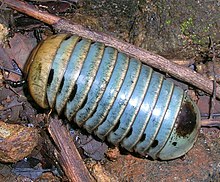Amynilyspedida
| Pill millipedes | |
|---|---|
 |
|
| A giant pill millipede from India. | |
| Scientific classification | |
| Kingdom: | Animalia |
| Phylum: | Arthropoda |
| Subphylum: | Myriapoda |
| Class: | Diplopoda |
| Subclass: | Chilognatha |
| Infraclass: | Pentazonia |
| Superorder: |
Oniscomorpha Pocock, 1887 |
| Orders | |
| Synonyms | |
|
Armadillomorpha Verhoeff, 1915 |
|
Glomerida
Sphaerotheriida
†Amynilyspedida
Armadillomorpha Verhoeff, 1915
Pill millipedes are any members of two living (and one extinct) orders of millipedes, often grouped together into a single superorder, Oniscomorpha. The name Oniscomorpha refers to the millipedes' resemblance to certain woodlice (Oniscidea), also called pillbugs or "roly-polies". However, millipedes and woodlice are not closely related, belonging to the subphyla Myriapoda and Crustacea, respectively.
Pill millipedes are relatively short-bodied compared to most other millipedes, with only eleven to thirteen body segments, and are capable of rolling into a ball when disturbed, as a defence against predators. This ability evolved separately in each of the two orders, making it a case of convergent evolution, rather than homology. They can also exude a noxious liquid, which may be both caustic and toxic, to repel predators. Pill millipedes are detritivorous, feeding on decomposing plant matter, usually in woodlands.
The order Glomerida is predominantly found in the Northern Hemisphere and includes species such as Glomeris marginata, the common European pill millipede. They have from eleven to twelve body segments, and possess dorsal ozopores (openings of the repugnatorial glands) rather than the lateral ozopores found on many other millipedes. Glomeridans reach maximum lengths of 20 mm (0.79 in), and eyes, if present, are in a single row of ocelli. The order contains approximately 450 species found in Europe, South-east Asia and the Americas from California to Guatemala. Four species are present in the British Isles.
...
Wikipedia
